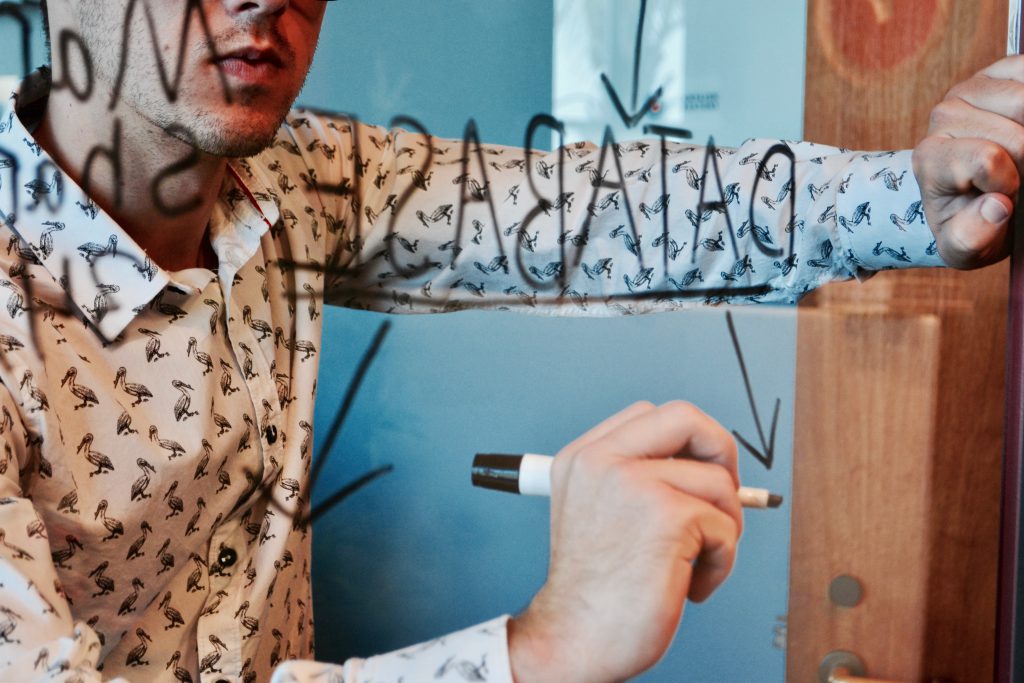Design thinking is a popular problem-solving framework that offers potential for organizations to improve their products, processes, and services with practices grounded in innovation. In fact, the Design Management Institute’s annual Design Value Index Study found that design-driven companies consistently outperform the S&P Index by up to 211 percent.
With its focus on collaboration, co-creation, and empathy, design thinking and social enterprises are a natural fit. When coupled with impact measurement tools, like the B Impact Assessment, conscious companies have an arsenal of creative problem-solving tools at their disposal.
So how can conscious companies put this creative approach at the heart of their own operations? In this article, we share how we do this at our own companies, as well as some practical tips for getting started yourself.
Design Thinking 101
Design thinking describes a model for innovation based on human-centered observation, collaboration, and prototyping. It’s not a specific process as much as it is a mindset, used to solve problems via many methods, from simple whiteboard exercises to multi-day design sprints. At its core, however, are several important principles:
- Question everything: All problems, assumptions, implications, etc. get scrutinized.
- Human-centered: People are at the heart of the design process.
- Visual: Information is communicated visually.
- Collaboration, inclusion, co-creation: Everyone has a voice.
- Iteration: Prototype solutions quickly in order to gather continuous feedback.
Depending on their level of design maturity, companies execute these principles in a variety of ways with varying success levels. Let’s explore what that means.
The Mindset Makes the Difference
Design thinking requires multiple voices, and that’s best when they are diverse. It also requires a shared mindset — one person not participating can derail the whole team’s progress. In creative problem-solving, Design thinking requires that we be:
- honest
- curious
- brave
- kind
As business owners, we’re always interested in making our processes more efficient. Most of the time we find the answer in fine-tuning these processes, which is often, but not always, a software issue. But as conscious companies, we wonder about the mindset needed to create more efficiency over time. Creating empathy and understanding among team members is one of the best ways to lock in high efficiency for the long term.
When people come together, they bring their own role and list of responsibilities to the table to work on a goal with other people. If the first design thinking session is successful, everyone agrees on the goal, but some might not understand what kind of effort other team members must contribute to achieve this shared goal. This takes time — and experimentation. Design thinking isn’t just a switch you flip on or off. It’s a mindset that takes concentrated effort to execute successfully.
Here are some things we have done at our own companies to embrace these principles.
Design Thinking at LimeRed
Last year at LimeRed I was planning the course of the business for the coming year and began listing tasks to reach our people, planet, and profit goals. The list quickly became overwhelming: Look for a new space, automate X and Y process, research new markets, consolidate reporting, make sure people are happy, it went on and on.It was not only going to take way longer than a year, I had no idea what to do first.
Then I realized I was approaching this list all wrong. Figuring out what to do was a problem I needed to solve, a problem that required more input than just mine. As a leader not only in a conscious business — LimeRed is a B Corp — we’re also design agency that uses human-centered design at its very core. One practice of that is design thinking, methods we have crafted to solve complicated problems. So why not use Design Thinking to help me figure out what to do?
Design Thinking Solves Problems Differently
Like I said before, my approach was all wrong: It was based in the old business culture of the solo leader, the trailblazing entrepreneur who carries the vision and burden on her own shoulders and dictates plans to her team. To be a different kind of leader who models inclusion, collaboration, and listening, I needed a new method. Design thinking, in this business case, was the solution to not only bring more voices to leadership, but to collaborate on what is important, and make that meaningful for everyone.
So I rolled this problem into a company-wide design thinking session. Design thinking is NOT planning. It’s not executing a solution. It’s not project management. It’s problem solving.
Here’s what we did:
- In a group setting, after we reviewed our people, planet, and profit goals for the coming year, I asked one question: What do we need to get there?
- Then, we created a landscape like this:

- Privately, for two to three minutes, everyone in the room, including me, wrote down one idea or thing we needed to achieve the goals we had all agreed on. Letting people work quietly alone provides more room for people who aren’t as comfortable in a group to get their ideas out.
- Then every person plotted their needs on the landscape we created and looked for patterns. Sure, some of the results were simply a fridge stocked with sparkling water, but others ended up more on the “need” side: professional development, more time with family, someone in X role.
- As a group, we then looked for concentrations: what were the things that most people needed most? Were there patterns? What was easy and hard? What was cheap and expensive? What would take the whole team and what could be one person’s task?
After we finished this session, I looked at the final map and I could see clearly what I needed to accomplish for my team. And therein lies the biggest difference: Me sitting alone making a list considered only my perspective. The design thinking method we used to generate this map worked because it contained everyone’s perspective.
This is what design thinking is designed to do:
- democratize input
- create consensus
- create empathy and understanding
- accurately frame a problem
- generate solutions
In planning sessions, we typically outline a series of tasks we all need to contribute to get to a shared goal. And in a team setting, we found that designers, developers, account managers, and clients all had very different ideas on how complicated or how much time a task could take. For a designer, creating a page for a website might be a relatively simple task, but for a developer, that page might have implications for other pieces that have already been built, or introduce a whole series of questions about how it should work.
This became a repeating problem that wasn’t an issue of efficiency, it was an issue of understanding. So we introduced a voting system to create conversations about these tasks and therefore more understanding.
Here’s how it works:
- Everyone receives a set of cards numbered from 1 to 4.
- When we talk about our individual responsibility contributing to a team task, we each rate the level of that task’s complexity from 1 (not complicated) to 4 (complicated).
- If everyone on the team all votes with the same number, we record that and move on.
- If not, we each explain why we voted the way we did and revote until we reach consensus.
- This helps create understanding for the task at hand, taking people from only looking at their own responsibilities to empathizing for others.
It sounds simple, but another key to executing design thinking well is having an expert facilitator who can bring a divergent groups together.
Design Thinking at Mightybytes
Mightybytes has been helping conscious companies and mission-driven organizations solve problems, amplify their impact, and drive measurable results for nearly 22 years now. Like LimeRed, which is just up the street from us, we are also a B Corp as well as a Public Benefit Corporation.
Our client the Alliance for the Great Lakes has a popular beach cleanup program called Adopt-a-Beach. Since 1991, Adopt-a-Beach has inspired volunteers to clean beaches all around the Great Lakes region. In 2018 alone, these efforts resulted in 35,606 pounds of trash being removed from area beaches during 900 cleanup events on all five of the Great Lakes.
The organization identified a number of problems with the Adopt-a-Beach service, ranging from communications issues to software glitches and data-tracking. To address these problems, they did what many organizations do: they issued an RFP.
While the document was filled with great details, we knew there were far more effective ways to address some of these problems, so we suggested a design sprint: a multi-day, hands-on workshop grounded in design thinking principles.

Over the course of a week and a half, we did the following for this design sprint:
- identify stakeholders: Prior to the sprint, we collaborated on identifying a diverse group of stakeholders with different priorities and perspectives to attend.
- problem-framing: A half-day workshop helped the team get clarity on which specific problem we wanted to solve and how to clearly define that problem.
- understanding: We then spent a full-day running various exercises, such as persona creation and customer journey mapping, meant to help everyone better understand the specific problem we hoped to solve.
- sketching: On this day, we sketched out ideas to visually communicate potential solutions and create consensus on the best ones.
- prototyping: One full day was spent collectively designing an interactive prototype to improve the experience for a key Adopt-a-Beach stakeholder group: volunteer team leaders.
- testing: On the last day, we ran several interviews where volunteer team leaders with varying levels of experience stepped through the prototype, offering feedback and asking questions along the way. Then we regrouped to reflect on what we had learned and identify next steps.
This experience generated a significant number of new ideas and helped everyone better understand the needs and pain points of a key constituent group, on whom the success of this program hinges. By the time our design sprint ended, the Alliance team gained several important benefits from the process:
- They had consensus on how best to address some of their program’s specific problems.
- They had a prototype that could be used to inform future design and development decisions.
- With the report we produced afterward, they also had a roadmap for how they might proceed.
- Finally, we also created a ‘parking lot’ during the sprint where we captured related ideas that arose during various brainstorming exercises. Any number of these ideas can be workshopped and run through similar exercises to create new products, services, or processes.
While our design sprint was run for a nonprofit’s beach cleanup service, the design thinking principles it’s grounded in can be applied to any complex business challenge and are especially relevant to conscious companies, who often look to solve social and environmental problems while also pursuing profit.
A design sprint is an ambitious undertaking that requires significant time commitments from a large group of stakeholders (we had thirteen people total, including the folks from Mightybytes and those we interviewed). If you can adopt a design thinking mindset, you can run exercises on any scale, as Emily noted above. It simply becomes how your organization solves problems.
Design Thinking at Your Company
Here are some practical tips conscious companies can use to embrace design thinking within your own organizations.
Curiosity and Optimism
It’s important to foster a culture of curiosity and optimism. Teams need the creative confidence that their ideas are worth exploring and will yield productive results. This comes from respecting everyone’s opinion and encouraging participation in democratic decision-making. For most conscious companies, this should be an easy transition.
Bring in the Humans
Design Thinking is about building empathy. The best way to drive empathy into any project is to put people’s needs at the heart of it. Identify stakeholders early on and make sure to get their input throughout. Be inclusive in your decision-making and respect diverse perspectives.
Make Something — Then Make it Again
Prototyping — the act of designing experiments to prove or disprove a concept — is at the heart of creative problem solving. Design thinking requires us to iterate and experiment. Whether it’s a simple paper sketch or a more sophisticated interactive digital mockup, the idea is to show, rather than tell, to get feedback and move things forward quickly. We must learn from failure and embrace ambiguity. By doing this, we design better solutions.
This transition can be tough for organizations that rely on command-and-control principles to operate or still view design in a more traditional sense: one step in a linear process rather than something that is iterative and organic. The uncertainty that comes with design thinking can be unnerving.
Closing Thoughts
Because it’s a problem-solving framework, the uses of design thinking are nearly infinite. However, it takes time — and lots of trial and error — to do this well. It’s not impossible. You just have to dedicate some resources to it.
For conscious companies, the collaborative and inclusive approach required by design thinking methods should be a natural fit. Plus, the best business solutions are easy to use, possible to execute, and economically viable. Because design thinking principles are aligned with all these outcomes, adopting the mindset can be incredibly useful for any organization.
Some Resources
If you’re interested in some of the resources we use regularly, check out:
Book: 101 Design Methods
We use this book all the time as a starting point and iterate as we learn more to make the models work specifically for impact-driven orgs and businesses.
Book: This is Service Design Doing
As every company becomes a services firm, making those services intentional in their delivery becomes crucial. This is especially important for conscious companies whose success depends on inclusive and more sustainable decision-making. This book includes dozens of design methods to try on your next project.
Book: Creative Confidence
A compelling read from the founders of IDEO, this book identifies principles and strategies to help you tap into your creative potential and be more productive and successful in work and in life.
Platform: Mural
Mural is an online collaboration software that acts like a virtual white wall. We use this to record and refine our in person sessions as well as run remote collaborative sessions when working across time zones.





